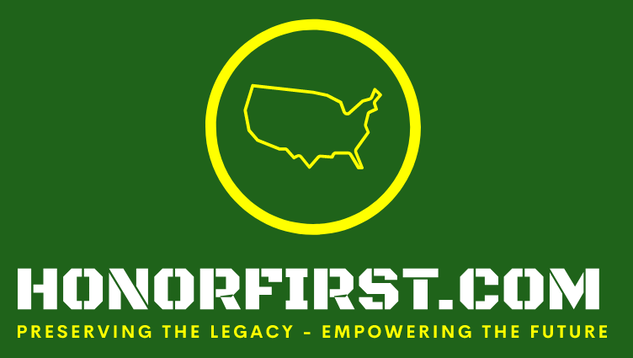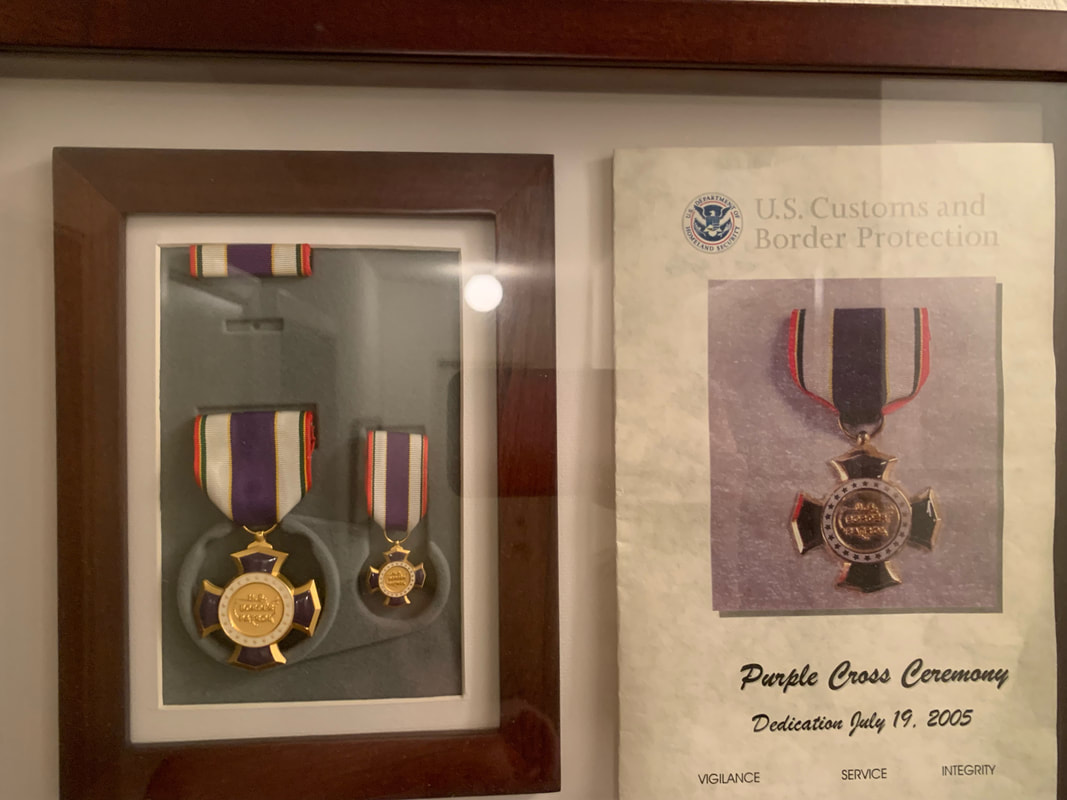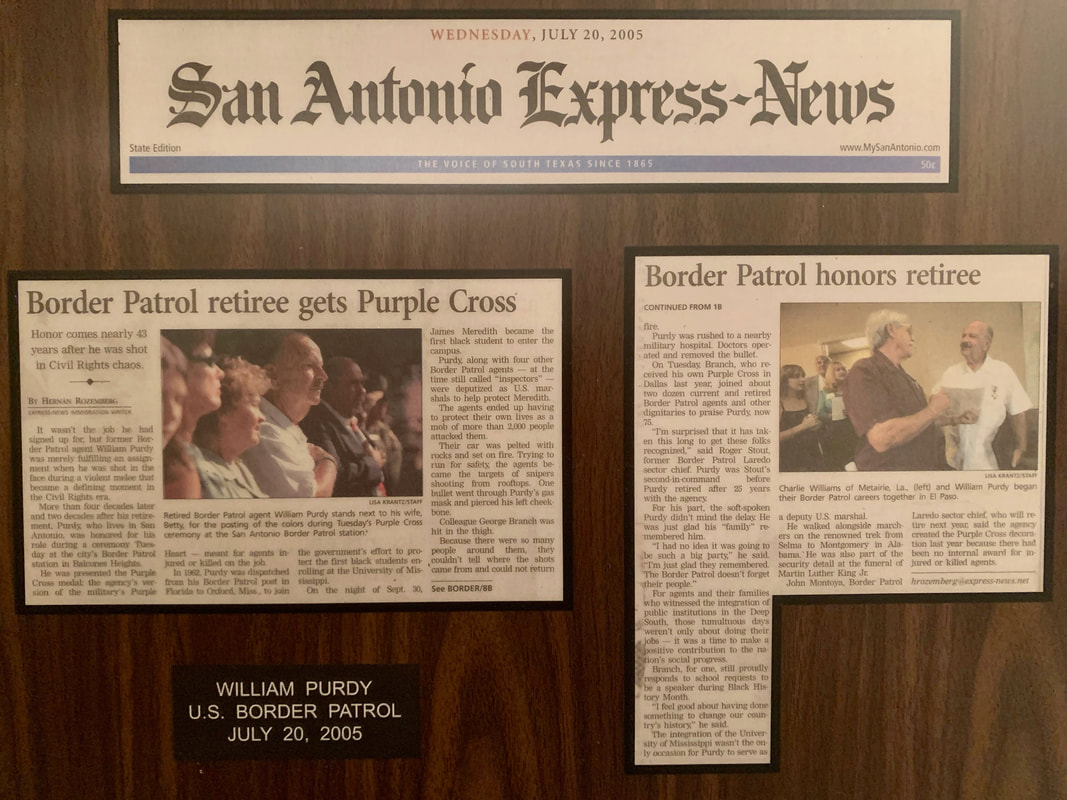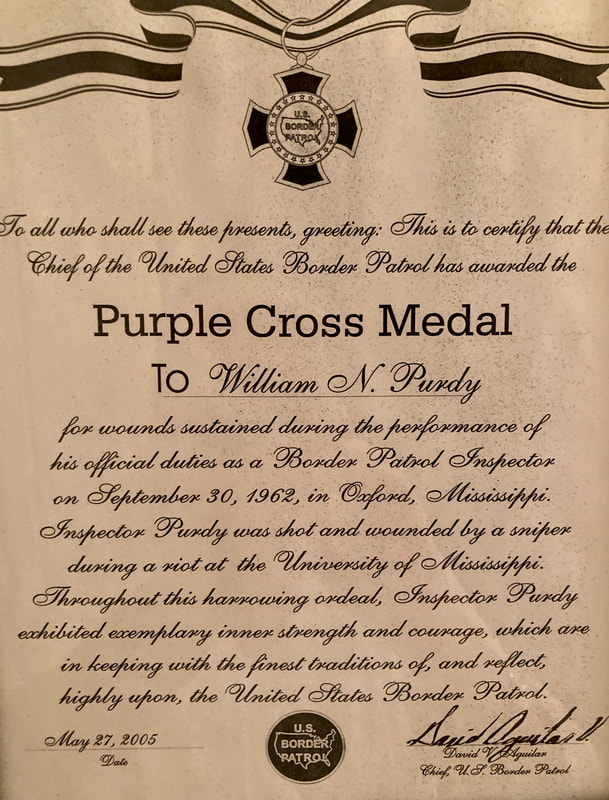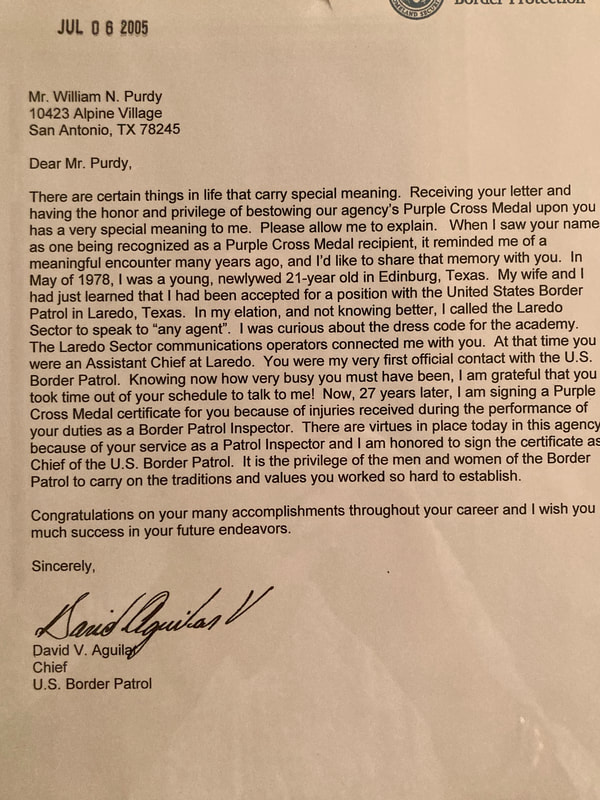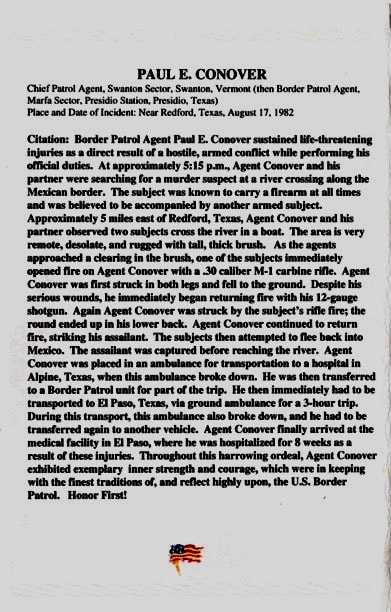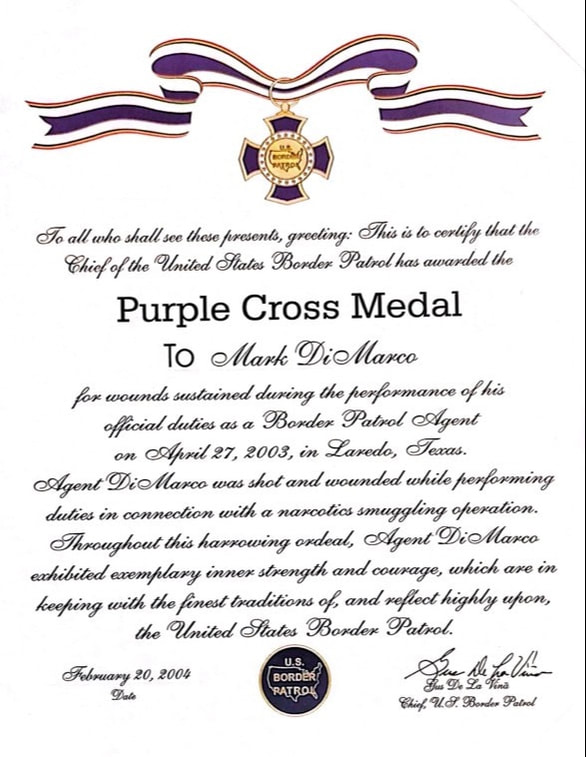USBP Purple Cross Recipients
This is the U.S. Border Patrol wound award. It may be used to commemorate injuries suffered in the scope of duty as well as injures due to assault related events.
USBP Purple Cross graphic by TIOH.
Criteria
May be awarded to any employee who, while in the scope of duty, sustains:
A special thanks to Joe Banco whose diligent work contributed greatly to this page.
This list is missing many Purple Cross recipients.
To add your USBP Purple Cross to this page, send an email to [email protected]. Please include a photo of the award, certificate and other relevant information.
USBP Purple Cross graphic by TIOH.
Criteria
May be awarded to any employee who, while in the scope of duty, sustains:
- Protracted or permanent impairment of any bodily function;
- Fatal injury;
- Injury as the result of an assault with a deadly weapon, which requires treatment by a medical professional; or
- Injuries attributed, directly or indirectly, from an attack by an assailant with the following factors:
- The injury or wound cannot be attributed to bravado or gross negligence; and
- Any act of valor may be distinguished with the addition of a "V" device to affix to the ribbon.
A special thanks to Joe Banco whose diligent work contributed greatly to this page.
This list is missing many Purple Cross recipients.
To add your USBP Purple Cross to this page, send an email to [email protected]. Please include a photo of the award, certificate and other relevant information.
Award links
Recipients
To see the full resolution of a photograph, please right click on the picture and open the image in a new tab.
|
William N. Purdy
To all who shall see the presents, greeting: This is to certify that the Chief of the United States Border Patrol has awarded the Purple Cross Medal to William N. Purdy for wounds sustained during the performance of his official duties as a Border Patrol Inspector on September 30, 1962, in Oxford, Mississippi. Inspector Purdy was shot and wounded by a sniper during a riot at the University of Mississippi. Throughout this harrowing ordeal, Inspector Purdy exhibited exemplary inner strength and courage, which are in keeping with the finest traditions of, and reflect, highly upon, the United States Border Patrol.
Note - Inspector Purdy also received a Letter of Appreciation from President Kennedy for this action. Follow this link to see that recognition.
|
William W. Dillender
Border Patrol Agent
Detroit, Michigan, December 14, 1978
For wounds sustained during the performance of his official duties as a Border Patrol Agent on December 14, 1978, near Detroit, Michigan, while engaged in a gun battle with an assailant. Throughout this harrowing ordeal, Agent Dillender exhibited exemplary inner strength and courage, which were in keeping with the finest traditions of, and reflect highly upon, the United States Border Patrol.
Border Patrol Agent
Detroit, Michigan, December 14, 1978
For wounds sustained during the performance of his official duties as a Border Patrol Agent on December 14, 1978, near Detroit, Michigan, while engaged in a gun battle with an assailant. Throughout this harrowing ordeal, Agent Dillender exhibited exemplary inner strength and courage, which were in keeping with the finest traditions of, and reflect highly upon, the United States Border Patrol.
Myron Merchant
Border Patrol Agent
Near Moors Forks, New York, October 14, 1979
On October 14, 1979, at approximately 10:30 p.m., a call was received by Border Patrol Agents at Rouses Point, New York, that two men were walking in a sparsely populated rural area south on Cannon Corners Road near Moors Forks, New York. Border Patrol Agent (BPA) Myron Merchant and another agent responded to the call. BPA Merchant took a surveillance position at the intersection of Cannon Corners Road and Route 11. Soon afterward, BPA Merchant saw two men walking a short distance from his location. Suddenly, the men ran into the woods. BPA Merchant notified the other agent by radio of the circumstances and followed the suspects into the woods. About fifty feet from the road, BPA Merchant came under close range gunfire. One shot struck him in the upper abdomen, knocking him to the ground. One of the assailants walked toward him and raised his weapon in an apparent attempt to kill him. BPA Merchant instinctively rolled on the ground as the assailant fired, narrowly missing him. BPA Merchant drew his weapon and returned the gunfire, killing the assailant. While seriously wounded, BPA Merchant marked the position of the dead man with his flashlight and then crawled on his back to the road where he was met by the agent he had earlier radioed.
During the gunfire, the second man fled. He was captured later at a New York State Police roadblock in Mooers, New York. BPA Merchant's ability and presence of mind to be able to give a description of the second man greatly contributed to his capture. The two men were later identified as two escapees who had been charged with murdering a Montreal, Quebec police officer and seriously wounding two other officers of that city. BPA Merchant's actions that evening reflect his great personal courage and presence of mind during an emergency life and death situation.
Border Patrol Agent
Near Moors Forks, New York, October 14, 1979
On October 14, 1979, at approximately 10:30 p.m., a call was received by Border Patrol Agents at Rouses Point, New York, that two men were walking in a sparsely populated rural area south on Cannon Corners Road near Moors Forks, New York. Border Patrol Agent (BPA) Myron Merchant and another agent responded to the call. BPA Merchant took a surveillance position at the intersection of Cannon Corners Road and Route 11. Soon afterward, BPA Merchant saw two men walking a short distance from his location. Suddenly, the men ran into the woods. BPA Merchant notified the other agent by radio of the circumstances and followed the suspects into the woods. About fifty feet from the road, BPA Merchant came under close range gunfire. One shot struck him in the upper abdomen, knocking him to the ground. One of the assailants walked toward him and raised his weapon in an apparent attempt to kill him. BPA Merchant instinctively rolled on the ground as the assailant fired, narrowly missing him. BPA Merchant drew his weapon and returned the gunfire, killing the assailant. While seriously wounded, BPA Merchant marked the position of the dead man with his flashlight and then crawled on his back to the road where he was met by the agent he had earlier radioed.
During the gunfire, the second man fled. He was captured later at a New York State Police roadblock in Mooers, New York. BPA Merchant's ability and presence of mind to be able to give a description of the second man greatly contributed to his capture. The two men were later identified as two escapees who had been charged with murdering a Montreal, Quebec police officer and seriously wounding two other officers of that city. BPA Merchant's actions that evening reflect his great personal courage and presence of mind during an emergency life and death situation.
|
Paul E. Conover
Chief Patrol Agent, Swanton Sector, Swanton, Vermont (then Border Patrol Agent, Marfa Sector, Presidio Station, Presidio, Texas) Near Redford, Texas, August 17, 1982
Citation: Border Patrol Agent Paul E. Conover sustained life-threatening injuries as a direct result of a hostile, armed conflict while performing his official duties. At approximately 5:15 p.m., Agent Conover and his partner were searching for a murder suspect at a river crossing along the Mexican border. The subject was known to carry a fIrearm at all times and was belleved to be accompanied by another armed subject. Approximately 5 miles east of Redford, Texas, Agent Conover and his partner observed two subjects cross the river in a boat. The area is very remote, desolate, and rugged with tall, thick brush. As the agents approached a clearing in the brush, one of the subjects immediately opened fire on Agent Conover with a .30 caliber M-1 carbine rifle. Agent Conover was first struck in both legs and fell to the ground. Despite his serious wounds, he immediately began returning fire with his 12-gauge shotgun. Again Agent Conover was struck by the subject's rifle fire; the round ended up in his lower back. Agent Conover continued to return fire, striking his assailant. The subjects then attempted to flee back into Mexico. The assailant was captured before reaching the river. Agent Conover was placed in an ambulance for transportation to a hospital in Alpine, Texas, when this ambulance broke down. He was then transferred to a Border Patrol unit for part of the trip. He then immediately had to be transported to El Paso, Texas, via ground ambulance for a 3-hour trip. During this transport, this ambulance also broke down, and he had to be transferred again to another vehicle. Agent Conover finally arrived at the medical facility in El Paso, where he was hospitalized for 8 weeks as a result of these injuries. Throughout this harrowing ordeal, Agent Conover exhibited exemplary inner strength and courage, which were in keeping with the finest traditions of, and reflect highly upon, the U.S. Border Patrol. Honor First! |
Arnold Forsyth
Border Patrol Agent
San Ysidro, California, April 17, 1984
For wounds sustained during the performance of his official duties as a Border Patrol Agent on April 17, 1984, in San Diego, California, while engaged in a gun battle with armed illegal aliens. Throughout this harrowing ordeal, Agent Forsyth exhibited exemplary inner strength and courage, which were in keeping with the finest traditions of, and reflect highly upon, the United States Border Patrol.
Border Patrol Agent
San Ysidro, California, April 17, 1984
For wounds sustained during the performance of his official duties as a Border Patrol Agent on April 17, 1984, in San Diego, California, while engaged in a gun battle with armed illegal aliens. Throughout this harrowing ordeal, Agent Forsyth exhibited exemplary inner strength and courage, which were in keeping with the finest traditions of, and reflect highly upon, the United States Border Patrol.
Guillermo D. Acosta
Senior Patrol Agent
Near Ysleta, Texas, October 14, 1985
For wounds sustained during the performance of his official duties as a Senior Border Patrol Agent on October 14, 1985, near Ysleta, Texas. Agent Acosta was shot and wounded by a lone gunman during a sniper incident. Throughout this harrowing ordeal, Agent Acosta exhibited exemplary inner strength and courage, which were in keeping with the finest traditions of, and reflect highly upon, the United States Border Patrol.
Senior Patrol Agent
Near Ysleta, Texas, October 14, 1985
For wounds sustained during the performance of his official duties as a Senior Border Patrol Agent on October 14, 1985, near Ysleta, Texas. Agent Acosta was shot and wounded by a lone gunman during a sniper incident. Throughout this harrowing ordeal, Agent Acosta exhibited exemplary inner strength and courage, which were in keeping with the finest traditions of, and reflect highly upon, the United States Border Patrol.
William V. Beaumet
Supervisory Border Patrol Agent
Vista, California, December 22, 1985
For wounds sustained during the performance of his official duties as Supervisory Border Patrol Agent on December 22, 1985, in Vista, California. Agent Beaumet was shot and wounded while engaged in the pursuit of an illegal alien. Throughout this harrowing ordeal, Agent Beaumet exhibited exemplary inner strength and courage, which were in keeping with the finest traditions of, and reflect highly upon, the United States Border Patrol.
Supervisory Border Patrol Agent
Vista, California, December 22, 1985
For wounds sustained during the performance of his official duties as Supervisory Border Patrol Agent on December 22, 1985, in Vista, California. Agent Beaumet was shot and wounded while engaged in the pursuit of an illegal alien. Throughout this harrowing ordeal, Agent Beaumet exhibited exemplary inner strength and courage, which were in keeping with the finest traditions of, and reflect highly upon, the United States Border Patrol.
Joe G. Zepeda, Jr.
Senior Patrol Agent
San Elizario, Texas, February 2, 1989
For wounds sustained during the performance of his official duties as a Border Patrol Agent on February 2, 1989, near San Elizario, Texas, while engaged in a gun battle with armed illegal aliens. Throughout this harrowing ordeal, Agent Zepeda exhibited exemplary inner strength and courage, which were in keeping with the finest traditions of, and reflect highly upon, the United States Border Patrol.
Senior Patrol Agent
San Elizario, Texas, February 2, 1989
For wounds sustained during the performance of his official duties as a Border Patrol Agent on February 2, 1989, near San Elizario, Texas, while engaged in a gun battle with armed illegal aliens. Throughout this harrowing ordeal, Agent Zepeda exhibited exemplary inner strength and courage, which were in keeping with the finest traditions of, and reflect highly upon, the United States Border Patrol.
Special Agent Keith Connelly
Special Agent Ted Jordan
Fresno, California, September 6, 1989
For wounds sustained during the performance of his official duties as Special Agents on September 6, 1989, in Fresno, California, while engaged in a gun battle with armed alien smugglers. Throughout this harrowing ordeal, Agent Jordan exhibited exemplary inner strength and courage, which were in keeping with the finest traditions of, and reflect highly upon, the United States Border Patrol.
On September 6, 1989, at 1:45 a.m., Anti-Smuggling Agent Keith Connelly was shot by alien smugglers in the city of Fresno, California, where he died shortly thereafter. He was working an undercover operation accompanied by his partner, Ted Jordan, who was also shot but survived the ordeal. The Fresno, California Police Department responded to the emergency assistance call and apprehended the suspects who were turned over to the FBI for prosecution.
Special Agent Ted Jordan
Fresno, California, September 6, 1989
For wounds sustained during the performance of his official duties as Special Agents on September 6, 1989, in Fresno, California, while engaged in a gun battle with armed alien smugglers. Throughout this harrowing ordeal, Agent Jordan exhibited exemplary inner strength and courage, which were in keeping with the finest traditions of, and reflect highly upon, the United States Border Patrol.
On September 6, 1989, at 1:45 a.m., Anti-Smuggling Agent Keith Connelly was shot by alien smugglers in the city of Fresno, California, where he died shortly thereafter. He was working an undercover operation accompanied by his partner, Ted Jordan, who was also shot but survived the ordeal. The Fresno, California Police Department responded to the emergency assistance call and apprehended the suspects who were turned over to the FBI for prosecution.
Juan Gutierrez
Senior Patrol Agent
Near El Paso, Texas, May 16, 1991
For wounds sustained during the performance of his official duties as a Border Patrol Agent on May 16, 1991, in El Paso, Texas, while involved in a confrontation with a knife-wielding suspect. Throughout this harrowing ordeal, Agent Gutierrez exhibited exemplary inner strength and courage, which were in keeping with the finest traditions of, and reflect highly upon, the United States Border Patrol.
Senior Patrol Agent
Near El Paso, Texas, May 16, 1991
For wounds sustained during the performance of his official duties as a Border Patrol Agent on May 16, 1991, in El Paso, Texas, while involved in a confrontation with a knife-wielding suspect. Throughout this harrowing ordeal, Agent Gutierrez exhibited exemplary inner strength and courage, which were in keeping with the finest traditions of, and reflect highly upon, the United States Border Patrol.
Gerald Wilke
Border Patrol Agent
Near Calexico, California, July 20, 1992
For wounds sustained during the performance of his official duties as a Border Patrol Agent on July 20, 1992, near Calexico, California, while engaged in a near-death struggle with an illegal alien. Throughout this harrowing ordeal, Agent Wilke exhibited exemplary inner strength and courage, which were in keeping with the finest traditions of, and reflect highly upon, the United States Border Patrol.
Border Patrol Agent
Near Calexico, California, July 20, 1992
For wounds sustained during the performance of his official duties as a Border Patrol Agent on July 20, 1992, near Calexico, California, while engaged in a near-death struggle with an illegal alien. Throughout this harrowing ordeal, Agent Wilke exhibited exemplary inner strength and courage, which were in keeping with the finest traditions of, and reflect highly upon, the United States Border Patrol.
Gregorio Reyes
Senior Patrol Agent
Near Fronton, Texas, March 22, 1993
For wounds sustained during the performance of his official duties as a Senior Border Patrol Agent on March 22, 1993, near Fronton, Texas, while engaged in a gun battle with armed drug smugglers. Throughout this harrowing ordeal, Agent Reyes exhibited exemplary inner strength and courage, which were in keeping with the finest traditions of, and reflect highly upon, the United States Border Patrol.
Senior Patrol Agent
Near Fronton, Texas, March 22, 1993
For wounds sustained during the performance of his official duties as a Senior Border Patrol Agent on March 22, 1993, near Fronton, Texas, while engaged in a gun battle with armed drug smugglers. Throughout this harrowing ordeal, Agent Reyes exhibited exemplary inner strength and courage, which were in keeping with the finest traditions of, and reflect highly upon, the United States Border Patrol.
Juanita Santana - photo
Border Patrol Agent
Tucson Sector
On June 29, 1995, Border Patrol Agent Juanita Santana of the Tucson Border Patrol Station, was assigned to patrol a major smuggling route south of Tucson, Arizona.
Shortly after 5:00 p.m., Agent Santana observed a suspicious vehicle and conducted a normal vehicle stop. When she reached the rear door of the car, the driver, without warning, pointed a handgun out of his window and immediately began firing at her. Two shots struck her in the chest directly over her heart. Both bullets were stopped by a bulletproof vest she was wearing. A third shot struck her left forearm and completely penetrated it below the elbow. The fourth shot struck her ammunition pouch, which was fastened to her gun belt. This fourth bullet disintegrated on impact and Agent Santana was struck in the abdomen by shrapnel from the bullet.
Although struck four times and seriously wounded, Agent Santana drew her revolver and returned fire at the driver. Agent Santana ran back to her patrol vehicle and immediately began to pursue the fleeing suspects. She radioed for assistance and informed the Communications Center that she had been shot. Even though she was injured and bleeding heavily, she maintained her composure and clearly broadcast all pertinent suspect information.
She also received the Newton-Azrak Award for this action.
Border Patrol Agent
Tucson Sector
On June 29, 1995, Border Patrol Agent Juanita Santana of the Tucson Border Patrol Station, was assigned to patrol a major smuggling route south of Tucson, Arizona.
Shortly after 5:00 p.m., Agent Santana observed a suspicious vehicle and conducted a normal vehicle stop. When she reached the rear door of the car, the driver, without warning, pointed a handgun out of his window and immediately began firing at her. Two shots struck her in the chest directly over her heart. Both bullets were stopped by a bulletproof vest she was wearing. A third shot struck her left forearm and completely penetrated it below the elbow. The fourth shot struck her ammunition pouch, which was fastened to her gun belt. This fourth bullet disintegrated on impact and Agent Santana was struck in the abdomen by shrapnel from the bullet.
Although struck four times and seriously wounded, Agent Santana drew her revolver and returned fire at the driver. Agent Santana ran back to her patrol vehicle and immediately began to pursue the fleeing suspects. She radioed for assistance and informed the Communications Center that she had been shot. Even though she was injured and bleeding heavily, she maintained her composure and clearly broadcast all pertinent suspect information.
She also received the Newton-Azrak Award for this action.
Arthur G. Lopez
Border Patrol Agent
Nogales, Arizona, August 10, 1995
On August 10, 1995, Border Patrol Agent Arthur G. Lopez displayed unusual courage during an incident in which he was critically wounded by gunfire along the U.S./Mexico international boundary.
At approximately 2:00 pm, Agent Lopez proceeded to an area along the border commonly known as Smuggler's Gulch. He was accompanied by BPA (I) Ronald Wehr and was assigned routine linewatch and patrol duties.
Agents Lopez and Wehr observed activity on the Mexican side of the international boundary fence that appeared to be Mexican police chasing individuals on foot. The Smuggler's Gulch area is a notoriously known canyon leading into the U.S. from Mexico that empties near the residential and business areas of Nogales, Arizona. It is frequently used by organized criminal groups for the purpose of smuggling undocumented foreign nationals, narcotics, and other contraband. It is also a favorite lair for border bandits who prey on their victims (other illegal aliens) as they cross from Mexico into the U.S.
As Agents Lopez and Wehr arrived at a high point on the U.S. side of the border that overlooks Smuggler's Gulch, they observed armed, uniformed individuals chasing and shooting at other individuals. The agents saw these uniformed individuals capture two, and then push and kick one of the people they were chasing. Upon discovering that they were being observed by Agents Lopez and Wehr, at least one of the individuals, later identified as Mexican police officers, began shooting at Agents Lopez and Wehr. BPA Lopez was critically wounded while attempting to run toward the steel border fence for cover. Agent Lopez fell to the ground but was able to crawl to the fence. He continued to give clear verbal instruction to BPA (I) Ronald Wehr the entire time. After ensuring the safety of his trainee partner and himself, Agent Lopez proceeded to call for assistance via his handheld radio. He informed other units that he had been shot and that he was continuing to receive gunfire from the Mexican police. He verbally directed the responding units to his location, advising them when it was clear to approach and the originating point of the assailant's gunfire.
His calm and composed actions during a very traumatic, critical moment most assuredly contributed to the safety of his partner, the responding units, and likely played a key part in saving his own life, as he was racing the clock against rapid loss of blood. He never lost consciousness, did not panic, and was able to clearly communicate the situation to the benefit of the responding Border Patrol units and other agency units.
Border Patrol Agent
Nogales, Arizona, August 10, 1995
On August 10, 1995, Border Patrol Agent Arthur G. Lopez displayed unusual courage during an incident in which he was critically wounded by gunfire along the U.S./Mexico international boundary.
At approximately 2:00 pm, Agent Lopez proceeded to an area along the border commonly known as Smuggler's Gulch. He was accompanied by BPA (I) Ronald Wehr and was assigned routine linewatch and patrol duties.
Agents Lopez and Wehr observed activity on the Mexican side of the international boundary fence that appeared to be Mexican police chasing individuals on foot. The Smuggler's Gulch area is a notoriously known canyon leading into the U.S. from Mexico that empties near the residential and business areas of Nogales, Arizona. It is frequently used by organized criminal groups for the purpose of smuggling undocumented foreign nationals, narcotics, and other contraband. It is also a favorite lair for border bandits who prey on their victims (other illegal aliens) as they cross from Mexico into the U.S.
As Agents Lopez and Wehr arrived at a high point on the U.S. side of the border that overlooks Smuggler's Gulch, they observed armed, uniformed individuals chasing and shooting at other individuals. The agents saw these uniformed individuals capture two, and then push and kick one of the people they were chasing. Upon discovering that they were being observed by Agents Lopez and Wehr, at least one of the individuals, later identified as Mexican police officers, began shooting at Agents Lopez and Wehr. BPA Lopez was critically wounded while attempting to run toward the steel border fence for cover. Agent Lopez fell to the ground but was able to crawl to the fence. He continued to give clear verbal instruction to BPA (I) Ronald Wehr the entire time. After ensuring the safety of his trainee partner and himself, Agent Lopez proceeded to call for assistance via his handheld radio. He informed other units that he had been shot and that he was continuing to receive gunfire from the Mexican police. He verbally directed the responding units to his location, advising them when it was clear to approach and the originating point of the assailant's gunfire.
His calm and composed actions during a very traumatic, critical moment most assuredly contributed to the safety of his partner, the responding units, and likely played a key part in saving his own life, as he was racing the clock against rapid loss of blood. He never lost consciousness, did not panic, and was able to clearly communicate the situation to the benefit of the responding Border Patrol units and other agency units.
Lawrence B. Pierce Jr.
Supervisory Border Patrol Agent
Chula Vista, California, August 17, 1995
On August 17, 1995, Supervisory Border Patrol Agent (SBPA) Lawrence B. Pierce Jr. was off duty, eating lunch with his son at a local establishment in Chula Vista, CA. At approximately 12:30 p.m., a subject entered the establishment and stabbed another patron. SBPA Pierce reacted, chasing the subject out of the establishment, catching up to him at a neighboring gas station. SBPA Pierce identified himself as a Border Patrol agent and instructed the man to drop the knife numerous times. The subject then stabbed SBPA Pierce, and Pierce died as a result of the injuries. SBPA Pierce’s actions were determined to be an approximate law enforcement response to an aggressive and violent subject committing a violation of law. The killer was apprehended, convicted of murder, and was sentenced to 39 years to life in prison.
Agent Pierce entered on duty with the U.S. Border Patrol on June 23, 1980, as a member of the 137th session of the Border Patrol Academy, and was assigned to the Campo Station in the San Diego Sector. Agent Pierce was a U.S. Marine Corps veteran and had served with the United States Border Patrol for over 15 years.
Supervisory Border Patrol Agent
Chula Vista, California, August 17, 1995
On August 17, 1995, Supervisory Border Patrol Agent (SBPA) Lawrence B. Pierce Jr. was off duty, eating lunch with his son at a local establishment in Chula Vista, CA. At approximately 12:30 p.m., a subject entered the establishment and stabbed another patron. SBPA Pierce reacted, chasing the subject out of the establishment, catching up to him at a neighboring gas station. SBPA Pierce identified himself as a Border Patrol agent and instructed the man to drop the knife numerous times. The subject then stabbed SBPA Pierce, and Pierce died as a result of the injuries. SBPA Pierce’s actions were determined to be an approximate law enforcement response to an aggressive and violent subject committing a violation of law. The killer was apprehended, convicted of murder, and was sentenced to 39 years to life in prison.
Agent Pierce entered on duty with the U.S. Border Patrol on June 23, 1980, as a member of the 137th session of the Border Patrol Academy, and was assigned to the Campo Station in the San Diego Sector. Agent Pierce was a U.S. Marine Corps veteran and had served with the United States Border Patrol for over 15 years.
John Pfeifer
Border Patrol Agent
Brunswick, Vermont, August 19, 1997
For wounds sustained during the performance of his official duties as a Senior Border Patrol Agent on August 19, 1997, near Brunswick, Vermont, while engaged in a gun battle with an armed murder suspect. Throughout this harrowing ordeal Agent Pfeifer exhibited exemplary inner strength and courage, which were in keeping with the finest traditions of, and reflect highly upon, the United States Border Patrol.
He also received the Newton-Azrak Award for this action.
Border Patrol Agent
Brunswick, Vermont, August 19, 1997
For wounds sustained during the performance of his official duties as a Senior Border Patrol Agent on August 19, 1997, near Brunswick, Vermont, while engaged in a gun battle with an armed murder suspect. Throughout this harrowing ordeal Agent Pfeifer exhibited exemplary inner strength and courage, which were in keeping with the finest traditions of, and reflect highly upon, the United States Border Patrol.
He also received the Newton-Azrak Award for this action.
|
Mark Di Marco
Senior Patrol Agent Jose A. Garza II Senior Patrol Agent Presented March 24, 2004 at the Laredo North Station. For wounds sustained during the performance of their official duties as Border Patrol Agents on April 27, 2003, in Laredo, Texas. Agent Di Marco and Agent Garza were shot and wounded while performing duties in conjunctions with a narcotics smuggling operation. Throughout the harrowing ordeal Agent Di Marco and Agent Garza exhibited exemplary inner strength and courage, which are in keeping with the finest traditions of, and reflect highly upon the United States Border Patrol. |
|
Karla L. Castellanos
Border Patrol Agent On October 21, 2023, U.S. Border Patrol Agent Karla Castellanos was performing her duties at the Law Enforcement checkpoint in Welton, within the Yuma Sector, when she was gravely injured by a vehicle crash. The incident resulted in severe injuries, including the amputation of her right arm. Due to the critical nature of her injuries, Agent Castellanos was immediately airlifted to a trauma center in Phoenix, where she remained in intensive care for three months. Despite the extensive physical trauma she endured, Agent Castellanos demonstrated remarkable resilience and determination. She has since recovered sufficiently to return to duty with the U.S. Border Patrol, exemplifying the highest standards of commitment and bravery. Agent Castellanos’s dedication to serving and protecting others has been evident throughout her career. Her valor and commitment in the face of such adversity embody the spirit and dedication recognized by the USBP Purple Cross. Her return to duty stands as a testament to her strength and perseverance. |
